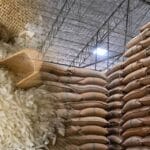Papad, a popular and versatile Indian snack, is now a household staple worldwide, creating a growing demand and papad making a lucrative venture. This guide will guide you through the essential steps to kickstart a profitable papad-making business. An inspiring case study is also provided for aspiring entrepreneurs.
Papad, or papadum, is a thin Indian wafer made from dried lentils, often described as a cracker or flatbread, enjoyed fried or roasted. It serves as a popular appetiser, gaining global popularity, especially in Asian countries like India, Pakistan, and Bangladesh.
Essential steps to start Papad making business
Varieties of Papad
Various types of papad are available in the market, typically crafted from different pulses. Notable examples include Urad Dal Papad, Moong Dal Papad, Aloo Papad, Rice Papad, and more. The shelf life of papad is approximately 2 1/2 to 3 weeks, making it suitable for small, medium, or large-scale businesses based on your investment capacity.
Some of the very well-known papads are: Urad Dal Papad, Moong Dal Papad, Aloo Papad, Rice Papad, Palak Papad, Methi Papad, Pudina Papad, Garlic papad, Poha Papad, Butter Milk Poha Papad, Shrimp Papad, Sabudana Papad etc.
Market Research for Papad Making
Before venturing into the papad making business, conduct thorough market research. Understand the demand for papads in your target market, identify competitors, and analyze consumer preferences. This information will help you tailor your product to meet customer expectations.
Therefore, before initiating this company, you must conduct a market survey. These days, papad comes in many different flavors and tastes. Thus, you have to comprehend the particular demand. In general, papad consumption is steadily increasing. And the demand generally grows in the winter season. This valuable information will shape your product to meet customer expectations.
Besides the retail supply, this product has an excellent institutional industry. The resorts, restaurants, student hostels, and hotels would be the frequent purchasers of papad.

Business Plan for Papad Making Business
Developing a detailed business plan is the key to success. Outline your goals, target market, marketing strategy, and financial projections. A well-thought-out plan will serve as a roadmap for your business and attract potential investors if needed.
Two critical factors determining aspects are the technical component and the financial component.
Technical Component: One of the major component of a business plan is technical component, it includes the industry opportunity, machine demand, raw material demand, and Generation technologies.
Financial Component: The next and essential part is the financial component. The financial part indicates the fiscal resources and sustainability of the business. Here, you need to consider the breakeven point, ROI, payback plan, and period. These all can help you not only in setting up the unit but also in obtaining finance from financial institutions such as banks.
Legal Requirements to Start a Papad Making Business
Starting a papad making business involves complying with various legal regulations to ensure the safety and quality of your products. Ensure that your business complies with all the legal requirements.
Ensure compliance with legal regulations for safety and quality. Follow these steps:
- Register your business entity.
- Obtain the mandatory FSSAI license for papad manufacturing.
- Register for GST online.
- Acquire a trade license from local authorities.
Business Registration: Start by registering your business entity with the appropriate authorities. Depending on your preference, it could be a sole proprietorship, partnership, or private limited company.
FSSAI License: The Food Safety and Standards Authority of India (FSSAI) is the regulatory body that governs food businesses in India. Obtaining an FSSAI license is mandatory for papad manufacturers.
GST Registration: Register for Goods and Services Tax (GST) as it is mandatory for businesses with an annual turnover above the specified limit. This registration can be done online through the GST portal.
Trade License: Obtain a trade license from the local municipal authority or panchayat. This license ensures that your business activities comply with local regulations.

Production Setup for Papad Making
Establish a dedicated production space with the necessary machinery for papad making. Ensure hygiene standards are met to produce high-quality and safe products. Invest in efficient equipment to streamline the production process.
Usually, two distinct kinds of machines are available for manual and automated operation. But you must select the machines based on your desired quality and quantity requirements.
- Choose between manual and automated machines based on desired quality and quantity.
- Consider a papad press machine for manual operation and additional equipment for dough preparation.
It is possible to operate the unit using a manual papad press machine. However, for dough making, you may need another machine, or you will be able to prepare the dough manually.
An automated operation integrated with dough making, papad making, and drier is also available. Moreover, you’ll have to secure a weighing scale and sealing equipment for packaging.
Machinery Requirement for Papad Making Unit
Major machinery and equipments are:
- Flour Kneading Machine
- Extruder Machine
- Dough Sheeter Machine
- Papad Cutter Machine
- Papad Drier Machine
- Hot Air Generator
- Control Panel Box
- Counting, Stacking & Packing Machine
- Other machine, kitchen tools and equipment
Raw Materials and Suppliers
The primary raw material of any papad is pulse flour. But, which particular pulse flour you require depends on the specific sort of papad that you would like to make. So in line with the taste and flavour, you need to arrange the raw material in a particular quantity and quality.
Source high-quality raw materials, primarily pulse flour, based on the type of papad you plan to make. Establish relationships with reliable suppliers to maintain a consistent supply chain of spices, edible oil, and packaging consumables.
Recipe Development for different types of Papads
You may prepare different types of papad with a blend of different pulses. Create a unique and delicious papad recipe by experimenting with different pulses. Develop flavors and textures that cater to diverse consumer tastes, setting your product apart in the market.
Production Process for Papad Making
Standardize your production process to ensure consistency in papad quality. Train your staff to follow procedures meticulously, from creating the dough to drying and packaging.
Follow these steps meticulously, ensuring a uniform product that meets customer expectations.
- Mix water, pulse flour, salt, spices, and sodium bicarbonate to create consistent dough.
- Form small dough balls and press them using a papad press.
- Dry papads using sun drying or electric dryers for a better appearance.
- Pack papads in printed plastic packs.
To start the papad-making process, carefully measured ingredients are combined in a dough-kneading machine, ensuring a thorough mix. The necessary quantity of water is introduced, and the entire mixture is kneaded at a minimal speed until a uniform dough lump is achieved. Following a 30-minute resting period for the dough to set, it is conveyed to an extruder through a hopper and feeder arrangement.
The extruder then produces a dough sheet of significant thickness, which is subsequently pressed to the desired thickness by a sheeter machine. The sheet is directed to a cutter machine once the required thickness (2 to 2.5 mm) is attained.
Operated by the papad cutting machine, the sheet is precisely cut into round shapes, with any remaining materials sent back to the extruder. Post-cutting, the papad undergoes a drying process through sun drying or a drying chamber where hot air at 35 to 40 degrees Celsius effectively removes moisture content.
The final step involves packaging the papad into printed plastic packs, each accommodating approximately 100 papads or as per market demand.
Manpower Requirement for a Papad Making Plant
The papad making process demands skilled machine operators to manage the machinery efficiently. Experienced quality engineers are crucial in ensuring the desired quality control standards. Additionally, helpers are required to seamlessly transfer materials between different workstations. Office staff is essential for maintaining proper documentation.
Approximately 8 individuals are needed for the papad making operation, comprising 1 Supervisor, 1 Plant Operator, 1 unskilled worker, 1 Helper, and 1 Security Guard. Furthermore, the team should include 3 skilled workers: an Accountant, a Manager, and a Salesperson. Each role contributes to the smooth functioning and success of the papad making process.
Packaging and Branding
Invest in attractive and informative packaging that highlights the qualities of your papads. Build a strong brand identity with a memorable logo and effective branding strategies to distinguish your products in the market.
Distribution Channels
Explore various distribution channels such as local retailers, supermarkets, and online platforms. Establish a reliable distribution network to reach a wider audience and ensure timely delivery.
Marketing and Promotion
Craft a marketing strategy utilizing social media, traditional advertising, and promotions to create awareness. Consider special deals or collaborations to boost initial sales. Retail supply is among the most proven procedures for distributing the finished product. Tap into the regional retail market and explore online marketplaces like Amazon.
Quality Control of Papads
Implement a robust quality control system to ensure that each batch of papads meets the highest standards. Regularly test and evaluate your products to maintain customer satisfaction and loyalty.
Customer Feedback and Improvement
Encourage customer feedback and reviews. Use this information to improve your products and address any concerns continuously. A responsive approach to customer feedback can help build a loyal customer base.
Conclusion
Starting a papad making business requires careful planning, dedication, and attention to quality. By following these steps, you can establish a successful venture that not only meets the demand for this beloved snack but also stands out in a competitive market. Remember to adapt and innovate to stay relevant and continue growing your business over time.
Case Study: Nurturing Success in the Papad Making Industry
In the bustling world of the processed food industry, the papad making business has emerged as a star, attracting entrepreneurs seeking a slice of the thriving market. This case study delves into the journey of Ms. Ananya Singh, an enterprising individual who turned her passion for papads into a flourishing business.
Ms. Ananya Singh, with a culinary background and a keen understanding of consumer preferences, recognized the untapped potential in the papad market. Motivated by the global popularity of this Indian snack, she set out to establish her own papad making business.
Starting any business involves overcoming challenges, and Ms. Singh’s journey was no different. Key obstacles included understanding the diverse market demands, setting up a production unit, and ensuring compliance with legal requirements.
Ms. Ananya Singh’s success story in the papad making industry exemplifies the potential within this niche market. Her journey, marked by meticulous planning, dedication to quality, and adaptability to market dynamics, serves as an inspiration for aspiring entrepreneurs looking to carve their niche in the ever-evolving world of processed foods.
STEPS TAKEN:
In-Depth Market Research:
Ms. Singh began her venture with thorough market research. She studied the demand for various types of papads, identified regional preferences, and assessed market gaps. This information was instrumental in tailoring her product range to meet consumer expectations.
Crafting a Business Plan:
A detailed business plan became the roadmap for success. Ms. Singh outlined her goals, identified the target market, devised a marketing strategy, and projected financial estimates. This comprehensive plan not only guided her business but also attracted potential investors.
Legal Compliance:
Complying with legal regulations was a meticulous process. Ms. Singh registered her business, obtained the mandatory FSSAI license, and ensured GST registration. This adherence to legal requirements laid a solid foundation for the credibility and safety of her products.
Setting Up the Production Unit:
Establishing a dedicated production space with the right machinery was crucial. Ms. Singh invested in efficient equipment, opting for a combination of manual and automated machines to achieve the desired quality and quantity. Hygiene standards were prioritized to produce high-quality, safe papads.
Raw Material Procurement and Recipe Development:
Building relationships with reliable suppliers, Ms. Singh sourced high-quality raw materials, experimenting with different pulses to create unique papad recipes. This focus on recipe development allowed her to offer a diverse product range catering to varied consumer tastes.
Quality Control and Innovation:
Implementing a robust quality control system ensured consistency in papad quality. Regular testing and evaluation became an integral part of the production process. Ms. Singh embraced innovation, constantly seeking ways to enhance her products based on customer feedback and market trends.
RESULTS
- Ms. Singh’s papad making business quickly gained traction in the market. The diverse product range and unwavering commitment to quality contributed to growing demand, both in the retail and institutional sectors.
- Investing in attractive packaging and effective branding strategies helped establish a strong brand identity. Ms. Singh’s papads became synonymous with quality and flavor, standing out in a competitive market.
- Through a well-established distribution network and strategic marketing initiatives, Ms. Singh’s papads found their way into local retailers, supermarkets, and online platforms. Social media campaigns and collaborations boosted brand visibility.
- Encouraging customer feedback and reviews allowed Ms. Singh to continuously improve her products. A responsive approach to customer concerns built a loyal customer base, ensuring repeat business and positive word-of-mouth.

















